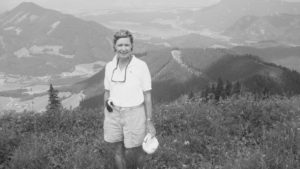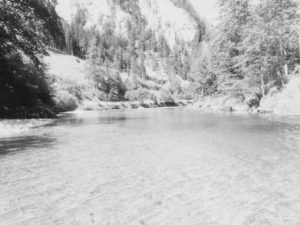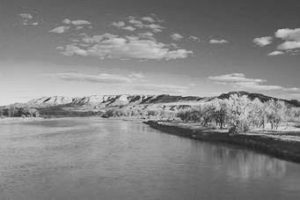 I turned south on the dirt road out of Craig, Montana, drove about a mile along the river and parked at a familiar spot – a slight rise overlooking the large corner pool that local anglers call “the bay of pigs”, presumably for the monster fish that inhabit its depths. I sidled down the first hill, then clambered over a railroad car that was part of a 5-mile string that the BNSF Railway had left on the tracks for the past six months, either due to the downturn in the economy or as punishment to the locals for voting down the conversion of the trunk line’s tracks into a bike path, dependent on whose version of the truth you chose to believe. After jumping off the railroad car, I slid down the grass on the next hill to the water’s edge, walked downstream to the first bend in the river, and began looking for noses and tails.
I turned south on the dirt road out of Craig, Montana, drove about a mile along the river and parked at a familiar spot – a slight rise overlooking the large corner pool that local anglers call “the bay of pigs”, presumably for the monster fish that inhabit its depths. I sidled down the first hill, then clambered over a railroad car that was part of a 5-mile string that the BNSF Railway had left on the tracks for the past six months, either due to the downturn in the economy or as punishment to the locals for voting down the conversion of the trunk line’s tracks into a bike path, dependent on whose version of the truth you chose to believe. After jumping off the railroad car, I slid down the grass on the next hill to the water’s edge, walked downstream to the first bend in the river, and began looking for noses and tails.
It was late July, about six in the evening on one of America’s great trout rivers. Prime time. From where I was standing, I could see up and down the broad Missouri for nearly a mile. Not another wade fisherman was in sight, even though both banks within my view (and all of the ten miles or so further upstream to the dam), are accessible to the public for wade fishing. As no fish were rising, my mind wandered, and I thought about how fortunate it is that I can drive along a river and walk in to fish almost any spot that I please. In the previous four days, I had a similar experience on two other legendary Western rivers – the Henrys Fork and the Madison – walking the banks and wading for many miles. Of course, most of our rivers can be accessed the same way. But, it is not everywhere thus.
 Just a few weeks earlier I had spent four days fishing one of the legendary trout streams of Europe – Austria’s Traun River –an hour east of Salzburg. Prior to that, I had fished (while Ann toured) the Loue River in eastern France with the Fario Club (the fly fishing club of Paris) for our annual outing, along with guests from the London and Munich Fly Fishing Clubs. The Loue is a beautiful river, and we had access to about six miles of it (all of which was private) through the extraordinary generosity of Fario Club members. Although the fishing was fine, it may have been surpassed by the food and wine, although my recollection of that is somewhat dimmed from overindulgence. Luckily for me, one thing I did recall was that a member of the Munich Club had provided me with an introduction to his friend, Erhard Loidl, a part owner of a fly shop on the Traun.
Just a few weeks earlier I had spent four days fishing one of the legendary trout streams of Europe – Austria’s Traun River –an hour east of Salzburg. Prior to that, I had fished (while Ann toured) the Loue River in eastern France with the Fario Club (the fly fishing club of Paris) for our annual outing, along with guests from the London and Munich Fly Fishing Clubs. The Loue is a beautiful river, and we had access to about six miles of it (all of which was private) through the extraordinary generosity of Fario Club members. Although the fishing was fine, it may have been surpassed by the food and wine, although my recollection of that is somewhat dimmed from overindulgence. Luckily for me, one thing I did recall was that a member of the Munich Club had provided me with an introduction to his friend, Erhard Loidl, a part owner of a fly shop on the Traun.
After dropping Ann off for her sojourn at a spa hotel in the charming Austrian lakeside town of Fuschl am See, I arrived at my hotel, the Wirt am Bach in Oberweis, near the Traun, and was greeted by Erhard. The Traun is restricted to fishing by permit, and only a few are available to the public for a daily fee of about S115 each. It’s a large river, flowing for 100 miles before reaching the Danube, and each of its angling sections has a different name. My permit covered an 8-mile stretch called the Gmundner Traun, which flows out of the Traunsee, a large lake girded by impressive snow-capped peaks.
 The Traun is a venerable fishery. Local records indicate that in the year 1360, a wealthy trader acquired the right “to fish for grayling and trout by means of feathered hooks” from the abbot of Lambach Monastery. That precedes the earliest known mention of fly fishing in English literature by 136 years. Sir Humphrey Davy, an Englishman who was the world’s greatest chemist during the first half of the 19th Century, the inventor of one of the earliest light bulbs, and a prominent angling author, praised the Traun’s beauty and its fish in his 1828 classic Salmonia or Days of Fly Fishing. The mid-20th Century writer and legendary international angler, Charles Ritz (also of hotel fame), was a devotee of the Traun. The prospect of fishing a river with such a storied history and tradition was exciting.
The Traun is a venerable fishery. Local records indicate that in the year 1360, a wealthy trader acquired the right “to fish for grayling and trout by means of feathered hooks” from the abbot of Lambach Monastery. That precedes the earliest known mention of fly fishing in English literature by 136 years. Sir Humphrey Davy, an Englishman who was the world’s greatest chemist during the first half of the 19th Century, the inventor of one of the earliest light bulbs, and a prominent angling author, praised the Traun’s beauty and its fish in his 1828 classic Salmonia or Days of Fly Fishing. The mid-20th Century writer and legendary international angler, Charles Ritz (also of hotel fame), was a devotee of the Traun. The prospect of fishing a river with such a storied history and tradition was exciting.
Although the Gmundner Traun flows through a busy, developed suburban area, it is gin clear and pristine. The river can rarely be seen from the road. Many of the fishing access points are very hard to find, and Erhard’s tour of them no doubt saved me many hours of frustration. Walking trails lead from the access points to the river and follow most of its length. The portion of the river that I fished was lined on both sides by a forest of mature trees, giving the feeling of fishing in a remote wilderness. The water was high for late June, and Erhard cautioned me that many good fishing spots would be inaccessible for wading. Although we saw few flies on the river, he suggested that a large green caddis, fished on the surface or below, would likely be the ticket, which proved accurate. As we stood above a riffle swapping fishing stories, I hooked several rainbows as my fly aimlessly bobbed up and down in the water – a good sign.
I asked Erhard about other Austrian rivers that he might recommend. He responded that Austria had the finest and most diverse trout fishing in Europe – but that all rivers are private. Most fishing rights are controlled by individuals, clubs or hotels and those that are accessible to the public require a permit, which often must be reserved in advance for a fee that is sometimes well in excess of what I was paying. I inquired how young people learn to fly fish. The answer is that they usually don’t unless they have a mentor who has fishing rights on a river, or they can learn on a lake. We discussed the relative merits of the American and Austrian systems, with Erhard pointing out the effectiveness of their system which puts fishing rights in the hands of those who are invested in, and are zealous about, protecting the fisheries from environmental abuse and overfishing, and me emphasizing that our system gives access to a valuable and pleasurable resource to those without power or wealth and creates wide public support for preservation of the fisheries. The Austrian system is the same as has existed throughout Europe for centuries, and is unlikely to change. Nor is ours. The discussion gave me a new appreciation for the privilege of my unfettered access to most American rivers. Would I trade this for private control (if I could afford and obtain it) of a few fine rivers near my home? Fortunately, there is no need for me to ponder this question.
The last stop on Erhard’s introductory tour was his fly shop in Steyermuhl, downstream from Oberweis. I bought some of his innovative caddis patterns, and he gave me a signed copy of the impressive book on entomology for European fly fishers that he and his partners produced in 2002, which is now available in many languages (not English). I can read scarcely a word of the German text, but it is beautifully produced with remarkable photographs of insects. Erhard then took me down a trail near the shop to a spot where the river backed up behind a weir, forming a large deep pool. He said that it was called “the place where fish always rise”. It was living up to its reputation at that moment, as many large fish were dimpling. The problem was getting a cast to them. The only place to stand was a narrow ledge about fifteen feet long in front of a wall, and a roll cast was required. Erhard pointed out to me that they were feeding on the small spinners (the stage in the mayfly’s metamorphosis after mating and egg laying, that lasts a few hours, just before death) that were on the water, and that, as I cast to them, they would spook, continually moving further away. They did. After about half an hour observing my futility, he left to drive to his home in Vienna, and I returned to the hotel to unpack. While walking back to the car Erhard pointed out a large pike lounging in a few feet of water near the bank. He said that pike of over 40 pounds had been caught in the river. I salivated.
That evening I couldn’t resist returning to the place of the rising fish – and they still were. I tied a small spinner on a very light leader, and began casting. Surprising myself, I hooked four fish. The first one showed why Traun rainbows are known for their fighting qualities. It took out line rapidly, got into my backing, then broke off. I changed to a slightly heavier leader and managed to land one of the other three – a beautifully colored and feisty 3-pound rainbow. While fishing, I witnessed something that I had not observed before. A group of about a dozen ducks were circling the pool, feeding voraciously on the spinners that blanketed the surface, and every half hour or so they would come around in front of me. They didn’t spook the fish, but during the ten minutes or so before they moved on, I had to suspend casting to avoid hooking a feathered sipper. I don’t know if the catch and release fishing regulations applied to ducks.
The next morning I walked down a driveway near the hotel, then through a yard to a section that has a series of islands. No fish were rising, so I put on a caddis nymph. On the third cast I hooked and landed a nice rainbow. Minutes later a brown, then a grayling and, finally, a beautiful brook trout. Four varieties in about an hour, while hardly moving. When I returned to the fly shop, I mentioned the brook trout to Erhard’s partner and co-author. He expressed disbelief, saying that in 25 years on the river he’d never heard of anyone catching a brook trout. Though doubting me, he made a phone call to a local fisheries biologist who confirmed that it was unlikely, but possible, as a few renegade brook trout could unintentionally be among the several thousand hatchery rainbows that are annually added to the wild fish in the river. I felt vindicated – and blessed.
Over the remainder of the three days I walked about five miles of the river, encountering only three or four other anglers. Although I didn’t see any wardens, anglers I met told me that there is little poaching, because if someone is caught, the penalty is severe. I continued to catch fish on a variety of caddis fly imitations. Every so often I would encounter a pair of white swans, a few with cygnets. They were the friendliest, or least intimidated, swans that I’ve met. Sometimes, when I had managed to get only a few feet out into the river, they would push me out a bit further, as they swam between me and the bank. I didn’t see them eating flies.
On my last afternoon, I fished a beautiful section that is known for having been a particular favorite of Ritz. A shallow riffle formed a delta-shaped shelf, with a prepossessing deep run on each side, turning into a long flat glide of over a hundred meters. A fishy looking spot indeed. I caught a few in the runs, and then saw a swirling rise about 20 yards out in the glide that was clearly a large fish, based on the amount of water that it pushed upstream. Four or five casts drifting a floating fly produced no response. Then I skittered the fly across the surface in front of where the fish had risen and it immediately rose and ate. It rolled and I could see that it was very large, undoubtedly one of the biggest fish of my life. A brown trout I guessed, given that it was feeding in slow water. After several long, powerful runs, I got it to within about ten yards of me, and the line broke. On examination, the break was neat, with no curlicue that would indicate a failed knot that I had tied. In my fashion, I mentally beat myself up for not having checked for knots caused by my poor casting, or abrasions, in the leader before trying for such a nice fish. To punish myself for my inattention to detail, I quit the river, and returned to my car to go pick up Ann and drive on to Salzburg.
If there is a lovelier country than Austria, I haven’t been there. The scenery around the many lakes east of Salzburg is spectacular. But even with such a distraction, as I drove I couldn’t get the lost fish, and my carelessness, out of my mind. Opportunities to catch unusually large fish are rare. Why am I not more disciplined and patient? How many more nice fish must I lose before I learn to take better care of my leader? Am I too old to shed my bad habits? If only I had gotten the fish in close to where I could see it, I would have felt much better. I was disconsolate. But then I remembered the large pike that Erhard showed me and his tale of the giants that inhabit the river, particularly in slower water. Yes, of course, it was a pike, whose sharp teeth would easily cut a trout leader. So, it wasn’t my fault. I was innocent. It was unavoidable. I was redeemed – and quite pleased that I had found the obvious answer. On such a slender thread hangs my optimism regarding my next fishing trip.


